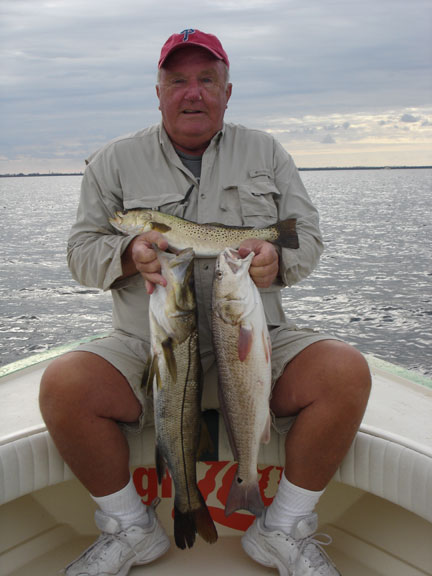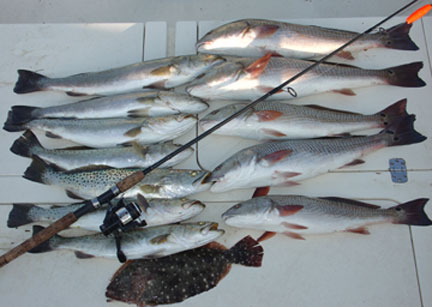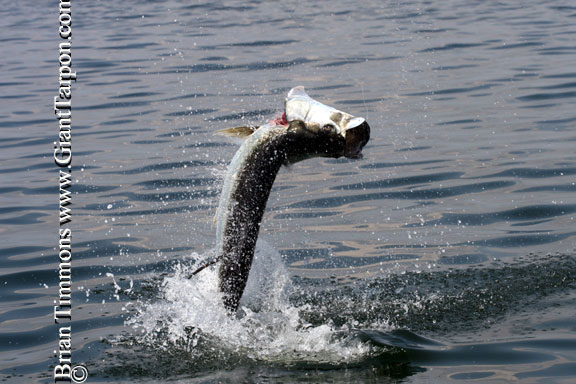|
While
many of the species have been in typical fall patterns for a couple of
weeks, remarkably missing was the ever so elusive snook. To some degree
the snook were present in places I had nearly unto myself until the late
90s, but that I choose to no longer fish due to over exposure resulting
in the fish's reluctance to bite. In our area, these spots still serve
as holding and staging areas for the fish, but the consistency of those
feeding snook is gone.
|
When I decided to concede to this modern
era of flats fishing, I knew I had to develop new strategies to
uphold my integrity as a fishing guide and still produce these
special fish on demand, even though they remain on the back page
of my daily playbook. I now rely on transition periods to produce
snook and those can be very difficult to predict in advance,
particularly in the fall. A passing front last week dropped the
water temperatures into the mid 70s. Accompanied with a waxing
moon, the snook started to show in my transitional spots and we
obliged.
Redfish have been
off the hook all year. Over the past several weeks, however, I
have not been finding the huge numbers of over-sized fish that I
had been catching last winter and spring. Double-digit catches
remain typical, though the fish I am catching are predominantly
lower- to mid-slot sizes. The undeviating
presence of the reds has kept the rods of happy clients bent and
that works for me too.
I have not spent a
lot of time targeting trout. For the most part, I have been able
to come up with a few trout on the hook during prolonged redfish
bites. Last week I had a trip with several youngsters on board and
found the trout off a hump in some deep grass flats very
cooperative on nearly every cast.
The winds have been up and that has made it a
day-to-day call in reaching the frenzied action on the outer edges
of our offshore grass flats. When the conditions are right, jumbo
Spanish mackerel, jacks, cobia, sharks, tarpon, grouper and the
oddball snake kingfish have been easy catches on one drop of the
anchor. |

Jack Hinkle with a "Slam" (snook,
redfish, trout)
|

Trout, redfish and an occasional flounder
are daily bags. Weather or not. |
Employing a fine tuned chum line of ground fish,
fresh dead bait and live scaled sardines over scattered rocks and
surrounding potholes in the grass has been staple to our success.
The most
consistent place for grouper has been on the 20-foot contour line
and west to 35 feet. Occasional run-ins with tarpon and offshore
redfish have occurred in these same areas, but with no rhyme or
reason. The key, as always, is the abundance of migrating bait.
Slow trolling live mullet and large blue runners have been
producing smoker kingfish off the tanks in Hernando and Pasco 4.
If you do not have large baits and patience, you will not know
they are there. The school kings and more frequent reports of
smokers are being caught primarily to the south where the runs to
the fish are much shorter and easier to stay on top of when
fishing. The winds and the phases of the moon are variables in
making these trips successful, if they even happen at all. |
|
Excellent
water quality this year likely played a major factor in the
phenomenal showing of tarpon in 2007. I had extended my stay to
the south into the second week of August this year. Family
commitments brought me back north, though I still continued to
make frequent visits to both Boca Grande Pass and Charlotte Harbor
until a couple of weeks ago.
The
giant tarpon took residence in some very familiar places,
and on exceptional outings, I was putting as many as a dozen
giants in the air. More often than not, we were blessed in
complete bliss without a boat in sight. To the north, scattered
fish remain off the beaches, in the bays, rivers and just offshore
in the potpourri of migrating baitfish. The fish are moving now
and that subjects us to dynamic unknowns
on a daily basis. For this reason, I avoid attempts at exclusively
targeting them, but I will accommodate them when we cross paths.
|

Thank you Megalops atlanticus for all
that you do.
|
|
The juvenile
tarpon have been consistent. Negative low tides have revealed them
in the lower bends of the rivers, canal junctions, and even on the
flats off the power plant. Their presence and temperament have
served us well in accomplishing the pinnacle of flats fishing, the
"grand slam" (tarpon, snook, redfish and trout).
Mother Nature will
daily dictate the availability of bait and particular species of
gamefish, as well as our ability to get to them as we move towards
winter. Only passing cool fronts followed by warming trends will
yield extended play.
I have been
contributing written fishing reports the St. Pete Times the
past couple of months and that has consumed some of my time in
writing for my own website. I will adapt in balancing my writing
time as I get more proficient in making this adjustment as a
glorified farmer. In the interim, you can follow these regularly
published reports by following this link to our Featured
Articles page.
Screaming
Drags and Tired Arms!
Robert McCue
|
|



![]()